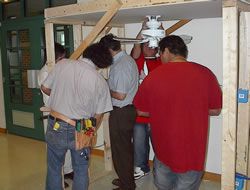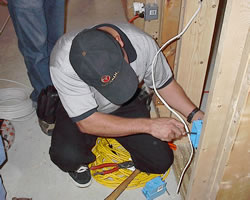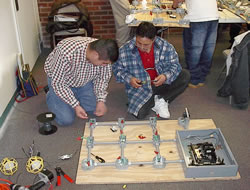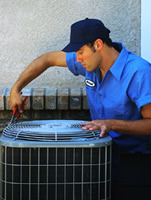APM Training Courses

APM offers the following courses:
Click a course to learn moreNext steps:
APM Vocational Institute's Electrical Apprenticeship combines practical experience with the Department of Labor approved Core Curriculum and Levels 1-4 of electrical craft training as designed by the National Center for Construction Education and Research. Our instructors create a culturally competent, bilingual atmosphere so that students may grasp advanced concepts quickly in Spanish, as well as build their working vocabulary in English. Students have the benefit of in-class training exercises and fieldwork under the supervision of the instructor.
APM's Electrical Apprenticeship is built to meet the varied needs of apprentices of all ages and backgrounds. Employers may arrange to host group classes at their job site on weeknights or students may pursue the program at community centers on the weekends. Upon entering the program, students take assessment tests to gauge gaps in construction math, science and other basic skills. Remedial instruction and weekend tutorials are offered in addition to the rigorous intensive apprenticeship. After students complete the fourth level they may choose to take the state exam to qualify for an electrician's license. Exceptionally experienced students may qualify to take advanced placement exams.
Electrical 1

Safety rules and regulations for electricians: Trainees learn the necessary precautions to take for various electrical hazards found on the job. Also teaches the OSHA-mandated lockout/tagout procedure. The course includes an introduction to blueprint reading which focuses on electrical prints, drawings, and symbols. Trainees learn the types of information they can find on schematics, one-lines, and wiring diagrams.
In-class exercises introduce conduit bending and installation: Covers the techniques for using hand-operated and step conduit benders, as well as cutting, reaming, and threading conduit. Covers the hardware and systems used by an electrician to mount and support boxes, receptacles, and other electrical components. Trainees also learn the various types of anchors and supports, their applications, and safe installation. Offers a general introduction to the electrical concepts used in Ohm's law applied to DC series circuits. Includes atomic theory, electromotive force, resistance, and electric power equations.
Series, parallel, and series-parallel circuits: Covers resistive circuits, Kirchoff's voltage and current laws, and circuit analysis. Focuses on proper selection, inspection, use, and maintenance of common electrical test equipment. Trainees get to practice using many of the instruments while learning the appropriate test procedures and safety rules. Other hands-on training includes residential and commercial wiring.
National Electrical Code: Trainees are introduced to the layout of the National Electrical Code book (NEC) and the types of information found within the code book. Trainees are able to practice finding information using an easy-to-follow procedure. Introduces the types and applications of raceways, wireways, and ducts. The appropriate NEC requirements are stressed. Focuses on the types and applications of conductors and covers proper wiring techniques. The appropriate NEC requirements are stressed.
Electrical 2

Among other advanced topics, the second level elecrical course focuses on forces that are characteristic of alternating-current systems and the application of Ohm's law to AC circuits. It covers AC and DC motors including the main parts, circuits, and connections. It explores the purpose of grounding and bonding electrical systems. Exercises on boxes and fittings explain how to select and size outlet boxes, pull boxes, and junction boxes. Conductor installation covers the transportation, storage, and setup of cable reels; methods of rigging; and procedures for complete cable pulls in raceways and cable trays. Familiarity with the National Electrical Code is increased including a focus on NEMA and NEC installation requirements for cable tray, including modifications and cable installations. The class further explores methods of terminating and splicing conductors of all types and sizes, including the preparation and taping of conductors. It covers methods and techniques for both single- and three-phase services, including metering equipment and NEC regulations. Students make presentations describing fuses and circuit breakers, contactors and relays, along with their practical applications. Short-circuit calculation is also covered. Second level students delve deeper into electrical theory including the basic principles of human vision and the characteristics of light. Focuses on the handling and installation of the different kinds of lamps (incandescent, fluorescent, and HID) and lighting fixtures (surface-mounted, recessed, suspended, and track lighting).
Electrical 3

Apprentices at the third level master the ability to do a load calculation. The course introduces the industry standards for electrical work, including the topics of branch circuits, rating and derating, and various types of residential and commercial electrical loads. It covers the types of conductors used in wiring systems, including insulation, current-carrying capacity, and temperature ratings. Class lectures stress the use of a variety of overcurrent protection devices, including circuit breakers and fuses, in all types of electrical systems. Students will demonstrate knowledge of raceway, box and fitting fill requirements. After discussing popular receptacles and switches the course takes an in-depth look at safety switches and other wiring devices. Explains distribution equipment, including grounding, switchboard and ground fault maintenance, transformers, and electrical drawing identification. Students will be able to discuss transformer types, construction, connections, protection, and grounding along with capacitors and rectifiers. They will become familiar with components including specific types of incandescent, fluorescent, and HID lamps, as well as ballasts, troubleshooting, and various types of lighting controls. The student will master single and multi-motor calculations to enable the trainee to size conductors, overcurrent protection, and overload protection for motor applications. Practical applications include proper maintenance of motors in use and in storage. Includes a troubleshooting and motor identification guide with information on selecting, sizing, and installing motor controllers. Also covers control circuit pilot devices and basic relay logic. Advanced safety training continues with a discussion of hazardous locations and the appropriate equipment for certain situations.
Electrical 4

Fourth level apprentices continue the practice of load calculations for Feeders and Services including both commercial and residential applications. They are often asked to discuss their on-the-job experiences and make presentations to their fellow students on practical applications of lighting including various lighting installations, applications, and wiring systems. NEC installation requirements for electric generators and storage batteries are fully explained. Students will be able to explains the function and operation of basic electronic devices, including semiconductors, diodes, rectifiers, and transistors. They will become familiar with fire alarm control units, Digital Alarm Communicator Systems (DACS), installation wiring for alarm initiating and notification devices, and alarm system maintenance.
The fourth level delves into various types of transformers and their applications. Also provides information on selecting, sizing, and installing these devices. Their study of Advanced Motor Controls explains applications and operating principles of solid-state motor controls, reduced-voltage starters, and adjustable frequency drives. It also covers basic troubleshooting procedures. Students will also review motor cleaning, testing and preventative maintenance. Fourth level students also receive a basic overview of HVAC systems and their controls with electrical trouble-shooting and NEC requirements.
Students will examine various heat tracing and freeze protection systems, applications and installation. This course includes an advanced overview of the NEC and cable manufacturers' requirements for high voltage terminations and splices.
HVAC Apprenticeship Program

Construction professionals attending APM Vocational Institute can now complete the U.S. Department of Labor approved National Center for Construction Education & Research apprenticeship program for HVAC craft professionals. The courses qualify for the trade's continuing education credit under NATE (North American Technician Excellence) criteria.
HVAC Level 1 provides 175 hours of accredited study including 72.5 hours of Core Curriculum trade foundations. Topics include trade math, copper and plastic piping practices, ferrous metal piping practices, basic electricity, introduction to cooling & heating, and air distribution systems.
HVAC Level 2 introduces commercial airside systems, duct systems, chimneys, vents and flues, hydronic systems, leak detection, evacuation, recovery and charging as well as control circuit troubleshooting.
HVAC Level 3 discusses refrigerants and oils, compressors, metering devices, retail refrigeration systems, steam systems, planned maintenance, water treatment, electronic controls, oil heating, heat pumps among other topics.
HVAC Level 4 provides advanced topical study of construction drawings and specifications, indoor air quality, energy conservation equipment, building management systems, water treatment, system startup and shutdown, heating and cooling system design as well as commercial and industrial refrigeration.